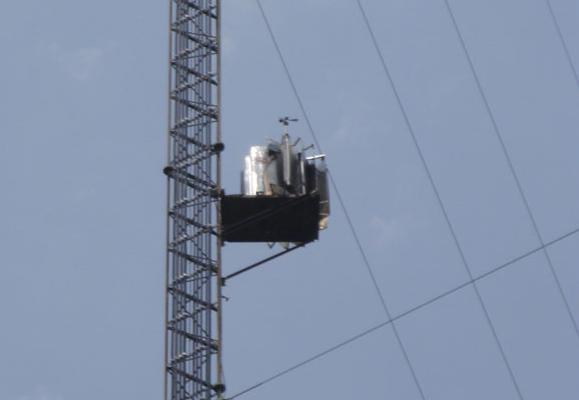Windturbines worden doorgaans op zee gepland, omdat de lawaaierige versnellingsbakken van de bekende molens op land voor protesten kunnen zorgen. Nieuwe varianten met 2 Db geluidsoutput (zacht fluisteren) zoals de DonQi, die bovendien de electriciteitsproductie aantrekkelijker verdelen (het waait ook als het donker is) lijken een gestage opmars te maken, ook dankzij de versoepelde behandeling van de noodzakelijke bouwvergunningen. In een toekomstig artikel meer over de DonQi.

DonQi
VAWT
Vertikaal assige windmolens, or Vertical axis wind turbines zijn evenzeer aan een welverdiende opmars bezig. De horizonale turbines zijn niet kosten effectief op te schalen. Zelfs een franse olie maatsschappij heeft ontwerpen van vertikale turbines.
"The major problem with a horizontal axis wind turbine (HAWT) is that all
materials and structural innovations will never completely remove the
restrictions on turbine capacity. A desirable long term objective will
be to aim for individual turbines with a capacity of 10 MW for
increasing efficiency with blades 120 m long and a tower of 200 m in
height. With current materials this structure is likely to disintegrate
under its own load in a very short period of time. " (bron)

"An alternative approach is to switch to a vertical axis arrangement. The
vertical axis wind turbines (VAWT) have been studied, relatively
unsuccessfully for many years. However new and improved designs, both in
terms of general configuration and blade section have made a vertical
axis 10 MW design look feasible. With constant cross section blades is
only having 100m in drop, and a sweep of 140 m in diameter. Critically
the blades with this uniform cross section could be opening to door to
low cost continuous manufacturing processes such as pultrusion. These
blades do not require feathering mechanisms and stall at excessive
speeds."
Patenten
Op dit blog wordt wel vaker patent onrecht aangeklaagd, maar dit keer is het toch echt een lachwekkend geval. Een patent met de naam "Vertical-Axis Wind Power Turbine System" doet namelijk iets dat eigenlijk nog niet eerder is vertoond, het claimt alle plaatsen waar een flinke vertikale wind turbine kan worden opgsteld, simpelweg door het opstellen van een windturbine op die plaatsen te patenteren!
" Generally speaking, the present inventive method and system comprise
identifying an existing structure having a capability of supporting a
wind turbine above the surface of the earth, mounting a vertical-axis
wind turbine to the existing structure, connecting a power generator to
the turbine, and permitting the wind turbine to operate. It is
understood that the mounting of the turbine to the existing structure is
done so as to avoid interference with normal operation of the existing
structure and the wind turbine. Also, the generator is connected to the
wind turbine in a manner which produces electricity as a result of the
turning of the wind turbine. "
De vinding houd in dat door een windmolen met of zonder extra montage materiaal op of aan een bestaande structuur te monteren tekortkomingen en uitdagingen van de "prior art" (dwz windmolen patenten) worden overwonnen. Het maakt ook een schatting van de toepassing van dit patent, dwz, op welke plaatsen de eigenaar van dit patent royalties kan claimen door gebruik van deze vinding.

Dat wordt dokken
"Currently, in the United States alone, there are said to be
approximately 170,000 cell towers, 450,000 billboards and more than 134
million utility poles. Road signs, water towers, and transmission towers
(also known as an "ironman" in Australia and a "hydro tower" in parts
of Canada)—the tall steel lattice towers used to support overhead
electricity conductors for electric power transmission—are also all
ubiquitous existing structures. Many of these structures already have
power transmission capabilities as well. [0005] By identifying such
structures as potential turbine sites, the present invention solves the
long-standing problem of providing structural infrastructure for modern
wind turbines. Where demand for power is greatest, the availability of
existing structures is also high. Accordingly, the invention maximizes
the potential of a green-energy source while simultaneously minimizing
both the environmental impact and the economic investment."
Dank voor de berekening 170,000 mobiele telefoon torens, 450,000 reclame borden en meer dan 134 miljoen lantaren palen e.d. Deze zijn door dit patent nu niet zonder meer te benutten voor plaatsing van een VAWT. Dit patent is werkelijk bijzonder omdat het automatisch een wereldwijd patent kan worden, en iedereen die vervolgens aan de montage van een turbine zit te denken door de patenthouder kan worden dwarsgezeten. Let wel dat u dan wellicht alleen te horen krijgt dat er geen vergunning kan worden verstrekt, en dus niet eens te weten komt dat VAWTs op hoge structuren effectief door het amerikaanse rechtsysteem zijn verboden. Ten minste : Tot we ze vertellen dat ze de boom in kunnen (zorg dat we niet vergeten hierop patent aan te vragen "Organisch geconstrueerde plek om woedende alternatieve energie gebruiker te onvluchten").
Dat heeft u niet zelf bedacht!